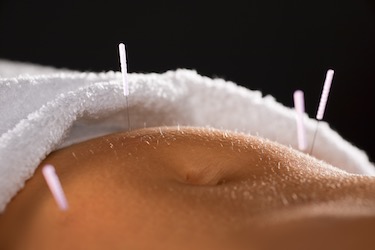Polycystic Ovarian Syndrome
Samples of Online CEU/PDA Course

Sample from the Introduction:
Imagine treating a teenaged patient whose parents have sought acupuncture to help relieve the daughter’s anxiety and irregular periods. During initial observations and review of her medical history, you notice the teenager has excess, thick facial hair and severe acne. She craves sweets and for the past year has been steadily gaining weight, particularly in the midsection. She also informs you since menarche at age 11, her periods have been irregular. Suspecting a hormonal imbalance, you recommend the patient has her hormone levels assessed by an endocrinologist or gynecologist. Lab results reveal elevated blood glucose levels and free testosterone levels. The endocrinologist concludes the 15 year old has polycystic ovarian syndrome (PCOS) and prescribes Metformin. The mother is completely surprised and inquires, “Isn’t PCOS something women who are trying to get pregnant have?”
Initially called Stein-Leventhal Syndrome for the doctors who first identified this condition, PCOS is a complex endocrine imbalance affecting women worldwide. PCOS is the most common endocrine disorder affecting women of childbearing age—approximately 6 – 10 % of women in this age range. The condition is also seen in prepubescent girls as early as 9 or 10 years old.
PCOS is not per se a disease but rather a pattern of symptoms including weight gain (especially around the waist), androgenism, balding, anovulation, infertility, irregular periods (anovulation disorder), insulin resistance, small ovarian cysts, slow metabolism, and depression. PCOS is not related to one particular dysfunction, rather it is a condition of multiple hormonal imbalances.
The term polycystic ovarian syndrome (or polycystic ovary syndrome) is somewhat a misnomer. It is worth mentioning that although the syndrome’s name includes…
More in course materials…
Sample from endocrine section:
Endocrine System Review
To better understand PCOS, let’s review how the endocrine system works and, in particular, how the pituitary functions and the link between insulin resistance and androgen levels. Recall the pituitary has two sections: the anterior and posterior lobes. In the anterior lobe, a number of key endocrine simulating hormones are produced affecting the adrenals, reproductive organs, and growth. These hormones include:
• Growth hormone affects most cells of the body.
• Adrenocorticotropic hormone affects the adrenals and stimulates release of cortisol and aldosterone.
• Thyroid-stimulating hormone (TSH) causes the thyroid gland to secrete thyroid hormone. In PCOS, an irregular or disrupted pituitary feedback loop affects TSH levels.
• Prolactin is an important hormone relative to PCOS because prolactin can greatly affect ovulation, which we will learn about later.
• Follicle stimulating hormone (FSH) stimulates the ovaries in women to develop/grow follicles, and in men FSH stimulates formation of sperm.
• Luteinizing hormone (LH) stimulates the ovaries to release estrogen and progesterone in women and the testes to release testosterone in men. Luteinizing hormone levels are ….
More in course materials…
Sample from another section:
PCOS Symptoms
Women presenting with PCOS exhibit a range of physical symptoms along with abnormal lab results. Some patients initially seek medical attention because of unusual weight gain, depression, acne, irregular periods, infertility, or excessive/abnormal hair growth. Some women have many of these symptoms, while others may only exhibit a couple. One common PCOS symptom is weight gain, especially around the midsection. However, not all PCOS patients are overweight; some may also be thin or normal weight. Another common symptom of PCOS is excessive or abnormal hair growth. When hair grows on women in a course and thick pattern, like male hair (on the chin, cheeks, upper lip, back, chest, stomach, inner thighs, and buttocks), the pattern is called hirsutism. When male-patterned baldness occurs in women, the condition is called androgenic alopecia. Women with PCOS may exhibit both hirsutism and androgenic alopecia. Some women with PCOS may experience flaps of skin on eyelids, armpits, neck, and back or darkening of skin in thick patches. The patches may occur under…
More in course materials…
Sample from the biomedical section:
Biomedical Diagnosis and Treatment of PCOS
Some patients find that obtaining a PCOS diagnosis is not easy. Currently, experts recommend at least two of the following features must be present for a PCOS diagnosis:
• Reduced ovulation or anovulation (menstrual irregularity)
• Hyperandrogenism
• Polycystic ovaries
The problem is a definitive PCOS diagnosis may be overlooked because symptoms from patient to patient vary, and some patients fail to reveal all symptoms during doctor visits. For instance, if a patient seeks help from a dermatologist for acne, the patient may fail to also mention that she only has a period once every three months. A 2005 Australian survey indicated a disparity between gynecologists and endocrinologists over what constitutes a PCOS diagnosis. While endocrinologists tended to require presence of…
More in course materials…
Sample from another section:
Etiology
Phlegm and damp retention are commonly present in PCOS cases. Excess phlegm and dampness may not be the only patterns seen with PCOS, which often involves linked patterns of both deficiency and excess. Yang Qi deficiency is commonly seen and in itself may produce phlegm because the qi is not moving and fluids are simply condensing. There also may be latent heat, which the body traps in fluid (damp-heat). Further, it’s common for some patients to show signs of emotional stress with Liver Qi stagnation simply because of the…
More in course materials including acupuncture points and herbal medicines…
More in course materials...


